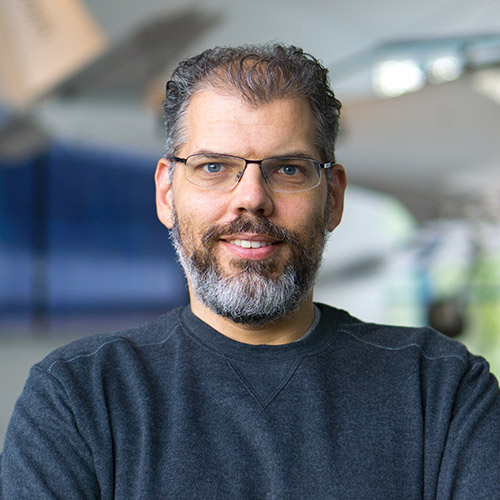He likes to give his students a glimpse of understanding so that they will dig deeper into the topic themselves. Calvin Rans, Assistant Professor in the Aerospace Structures and Materials Department, enjoys the art of engaging people in very complex ideas and concepts. And so successfully that he was elected both Teacher of the Year 2017-2018 at the Faculty of Aerospace Engineering, Delft University of Technology and Best Lecturer of TU Delft 2018. ‘Students won’t learn from what you say in the classroom. Just like kids, they have to make the mistakes themselves. This means that you have to find a way to help them navigate through their own learning process.’
On behalf of the LR Faculty, Calvin received a little art deco style metallic aircraft ‘flying’ over half the globe. ‘Ironically, I have an exact duplicate of the statuette at home. My wife bought it a few months ago, completely by chance!’ The prize from the entire university includes a certificate and a sum of money. The awards are a recognition for Calvin’s excellent work at TU Delft. ‘I like my students to apply the knowledge they’ve acquired from courses in some way that’s useful and focus on that rather than on their grades. Of course, students have to pass exams. But I stimulate them to be more satisfied with the understanding they gain than with a grade.’
p>Calvin Rans studied Aerospace Engineering at Carleton University, and then held a post-doc position at TU Delft. His research background and all of his professional activities have been involved the fatigue and damage tolerance of aircraft structures, in particular: damage-tolerant design and additive layer manufacturing (3D printing). At the bachelor’s level, Calvin teaches ‘Mechanics of Materials’ (1st year) and ‘Structural Analysis and Design’ (2nd year); at the master’s level, he teaches two courses: Joining Methods and Forensic Engineering. Online, he teaches ‘Air Safety’ and is involved in the ‘MOOC Introduction to Aerospace Structures and Materials’.
Online teaching
Calvin is a big proponent of online teaching. ‘Using online content helps automate many aspects of teaching. It also opens up more time and opportunity for interaction and engagement with students. Online education does not replace on-campus teaching. It basically creates new avenues to disseminate knowledge to different groups of people.’ The ‘Mechanics of Materials’ lecture course for which Calvin was nominated provided a completely blended teaching experience. ‘All of the lecturing was done with online videos that I had made, opening up more class time to discuss the connection of the theory to aerospace applications. The first-year students really appreciated getting this extra context behind what they were learning.’
Second-year students complimented Calvin on his redesign of the ‘Structural Analysis and Design’ course: a heavily mathematical course with a huge failure rate. ‘I completely changed the focus to understanding the underlying concepts hidden underneath the complex math. One of the changes we made was to create an exam not based on individual questions but questions that followed a design process. All the questions were related to a specific application, providing a unifying context for the exam. However, each question was formulated in such a way that the numerical answers did not depend on one another, minimizing the risk of continuation errors. This allowed the students to reflect on their answers and to make connections with their previous learning activities to see how concepts are actually related to applications.’
Magic trick
Calvin’s ‘magic trick’? ‘I always try to show the connection between theory and practice. I use my own research projects, case studies or even certain projects being addressed in other courses. Sometimes I bring in some very interesting, complex organic shapes that have been 3D-printed to give an idea of the direction in which we are going. We then break it down so that the students can get a better idea of the structural elements they have been studying. It gives them something to connect with.’ Being an entertainer is also crucial. ‘It helps to get people in a relaxed state of mind so that they can reflect and think about things. That’s why I bring cartoons into my class. And when I do a presentation of bending deflection, I bring in hockey sticks and we do an analysis of a hockey player doing a slapshot. These little things make it fun and encourage students to interact.’
Calvin has always been interested in figuring things out. ‘And I found that the easiest way to really figure something out is to be able to explain it to someone else. So, for me, teaching became a way for me to learn.’ For education in the future, he foresees classroom environments full of challenges and problems to be solved in which students have access to small online modules or lectures for what they need to learn. ‘Of course, this will require a different type of teacher: a mentor who guides students toward what they need to learn. Some universities are already playing with this idea.’
The TU Delft DreamTeams composed of students who work on a project for a year are a fantastic example of this approach. ‘In this case, the university gives these students access to the information they need for their project, but they are not learning just to pass an exam; they are trying to make their project work. This tends to be the most useful education experience for them. I hope universities will be heading in this direction in the future.’
